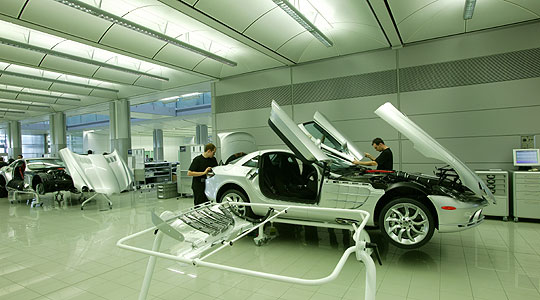
The production of the Mercedes-Benz SLR McLaren at the McLaren Technology Center in Woking, England, combines the best of two worlds: the advantages of the Mercedes-Benz Production System and the expertise of McLaren when it comes to building super sports cars.
On May 12, 2004, the McLaren Technology Center was officially opened by Her Majesty The Queen, accompanied by His Royal Highness The Duke of Edinburgh. The McLaren Technology Centre is the new corporate headquearters for the McLaren Group, in which DaimlerChrysler holds a 40-percent share. Around 140 highly qualified employees manufacture up to 500 units of the Gran Turismo in Woking each year. The SLR is available in limited numbers, in keeping with its exclusive character. During the vehicle’s seven-year lifespan, a total of 3,500 units will leave the Woking plant, which is equipped with the very latest in production technology. Overall, the McLaren Technology Centre measures approximately 22,500 square meters, of which 4000 square meters are accounted for by Mercedes-Benz SLR production.
The Mercedes-Benz SLR McLaren embodies the tradition and fascination of the Mercedes-Benz brand. Another aspect, the close association of the super sports car with Formula 1 motor racing, is emphasized by the production location at the McLaren Technology Centre which also houses the Team McLaren Mercedes’ Formula 1 activities. Three of the seven production fingers in the building complex are dedicated to the painting and final assembly of the SLR. The remaining four production fingers are reserved for the Team McLaren Mercedes Formula 1 team, McLaren Electronic Systems, McLaren Marketing and McLaren Applied Technologies.
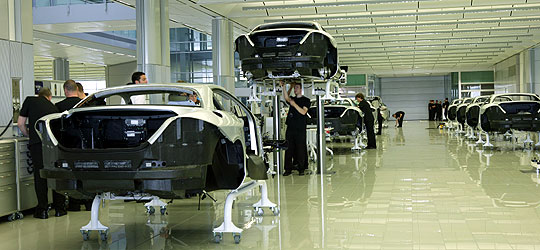
High-end components for unique high-performance sports cars
The 21st-century Silver Arrow is manufactured in Woking using high-end components produced by specialists from the partner companies Mercedes-Benz and McLaren. The 460-kW/626-hp V8 engine comes from Mercedes-AMG GmbH in Affalterbach, while the specialists from McLaren Composites in Portsmouth deliver the body-in-white, which is made of carbon fiber. The individual components are assembled to produce the complete vehicles at the McLaren Technology Center, the center of SLR production.
The bodies-in-white are shipped to Woking from Portsmouth, around 100 kilometers away. In the paint shop, which is conveniently located opposite the final assembly hall, the carbon fiber surface is painted by means of a special process. The final assembly of the Gran Turismo is largely performed by hand and takes place at nine stations along a line that is around 80 meters long. Each step is carried out in line with the standards and processes of the Mercedes-Benz Production System, which was adapted to take into account the special requirements in the production of the SLR.
The cars produced in Woking pass through a quality gate before moving on to each following station, ensuring that standards are uniform and remain consistently high. Following the assembly process, each vehicle undergoes a final test on the rolling test rig in addition to driving tests to fine-tune the chassis. The car may be delivered to the customer only after the quality inspector and the test driver have given the go-ahead.
The production process for the Mercedes-Benz SLR McLaren was thoroughly tested and optimized even before series production was launched. In order to prepare the employees for the special requirements associated with this particular series production run, the production technicians made the SLR prototypes as well.
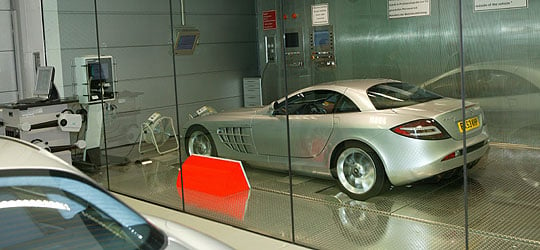
Automated production of CFC components introduced
At the McLaren Technology Centre, high-tech materials from the aviation sector and Formula 1 are being used for the first time in the series production of the body and chassis. The SLR’s doors, hood and complete body-in-white are made from carbon-fiber composites, or CFCs. Previously, CFC components were built by hand in a time-consuming process. In order to achieve a high degree of automation, McLaren worked with experts from the Mercedes-Benz Technology Center in Sindelfingen to divide the production process into a “preform” stage and a resin saturation stage followed by the hardening phase. The materials experts drew on the skills of the textiles industry in order to produce the preform, which also consists of carbon fibers, in a largely automated process. Traditional textile processes such as stitching, knitting, weaving and braiding were adapted for the production of high-performance CFC fibers.
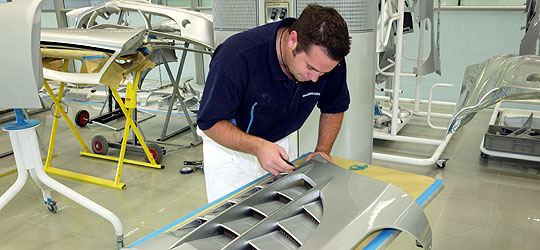
For example, the longitudinal members of the front body structure consist of a central cross member and the encircling molded part or internal web. The cross member comprises several layers of carbon fiber stitched together by a machine. After the form has been cut to shape, the web blank is inserted into a braided polystyrene core. This core element is clamped into a specially developed braiding machine that produces the longitudinal member from 25,000 ultra-fine carbon filaments that are unwound simultaneously from 48 reels. This process allows the fibers to be braided around the core at a precisely defined angle to create the desired contour. Several layers are overlapped in certain areas, depending on the thickness required.
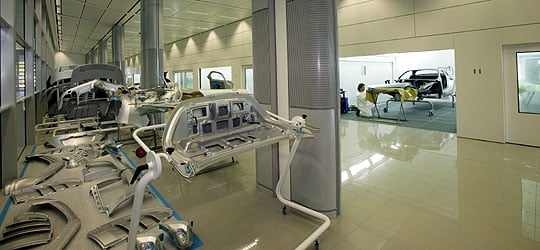
In a further manufacturing process, a computer-controlled tufting machine such as those used in the textiles industry joins the cross member to the braid of the longitudinal member. The braid core is removed and the preform of the longitudinal member is cut to the correct size. The preform is then injected with resin. Mercedes-Benz requires a cycle time of just 12 minutes to manufacture the complex fiber structure of the longitudinal members using a braiding machine. This illustrates the potential production capacity that this innovative manufacturing technology offers for the future.
New method for manufacturing the rear shelf structure
The rear shelf structure of the new SLR provides a further example of the new production techniques for carbon-fiber processing. It has a very complex shape with several apertures, yet it is automatically manufactured as a single part. To achieve this, Mercedes-Benz and its collaborative partners adapted the Sheet Molding Compound (SMC) method to create "Advanced SMC." Its advantage is that the carbon fiber mats are no longer manufactured by hand but by machine. Here, a handling system positions individual CFC layers at precalculated angles and in preset positions which correspond to the principal shape of the component, thereby creating the blank. Under heat this blank is then pressed, and in the process it takes on the precisely calculated form of the rear shelf. No subsequent reworking is therefore required. In the SLR series, Mercedes-Benz is the first automotive brand to use components that are manufactured using the Advanced SMC method.
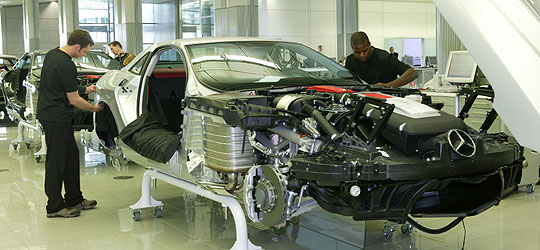
McLaren Composites also manufactures over 50 carbon fiber components for the high-performance sports car. The degree of integration achieved in the manufacture of the bodyshell is remarkable. The entire floor assembly, for example, including all support members and securing elements, is made from one piece. The core of the carbon fiber composite roof frame structure (also manufactured as a single piece) are automatically filled with foam before the resin injection, creating a particularly crashproof sandwich structure. High-strength bonding and riveting techniques ensure a reliable connection between the individual carbon components of the chassis and the bodyshell. The aluminum engine mounts are bolted to the carbon fiber composite bulkhead and also bonded in place. The carbon structure includes integral mountings for the aluminum and steel rear axle.
"One man, one engine" principle for the SLR
The "one man, one engine" principle is applied to the production of the high-performance 5.5-liter engines for the Mercedes-Benz SLR McLaren, which is conducted in a specially equipped hall at Mercedes-AMG’s engine production facility in Affalterbach. The decision to bring AMG on board as the engine supplier for the SLR ultimately benefits the customers of the Mercedes-Benz SLR McLaren, thanks to the company’s proven technology and its long-standing expertise in the construction of high-performance engines. The responsible engineer puts his or her signature on the engine tag of the AMG V8, documenting the company’s philosophy of exclusivity for the customer. What’s more, the signature guarantees highest quality and care.
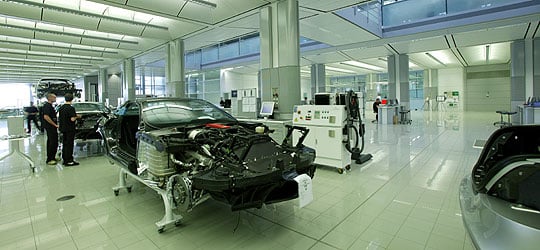
Exclusive setting in Woking reflects customers’ expectations
Designed by Lord Norman Foster, the exclusive architecture of the McLaren Technology Center not only offers the ideal conditions for the production of the super sports car, it’s also in keeping with the expectations of the SLR’s exclusive clientele. Consequently, the focal point of the SLR sales concept is located at the McLaren Technology Centre as well. The SLR Experience Center is designed to meet the specific needs of the customers of the Silver Arrow for the 21st century.
Text & Photos: DaimlerChrysler







